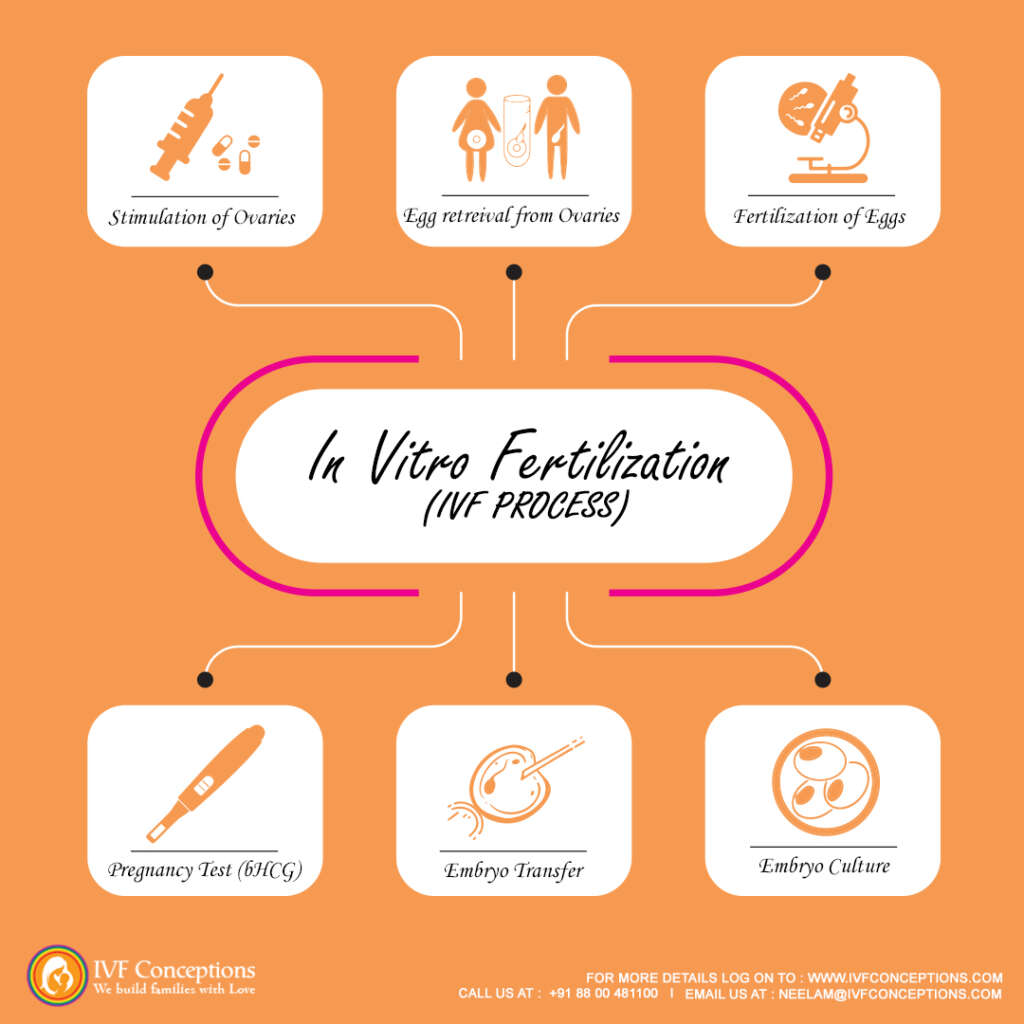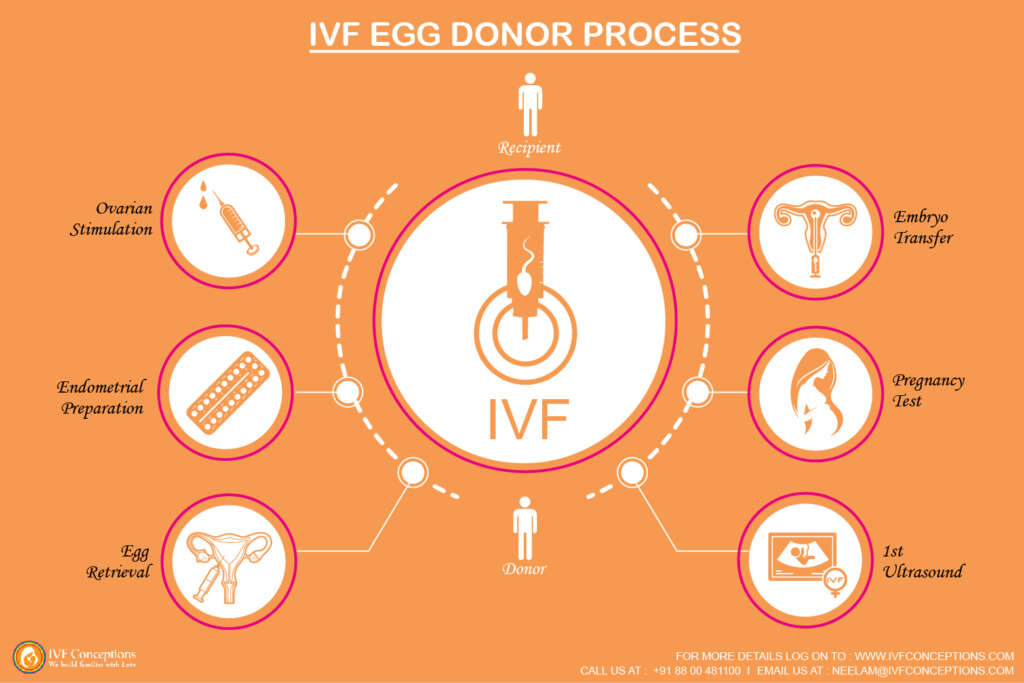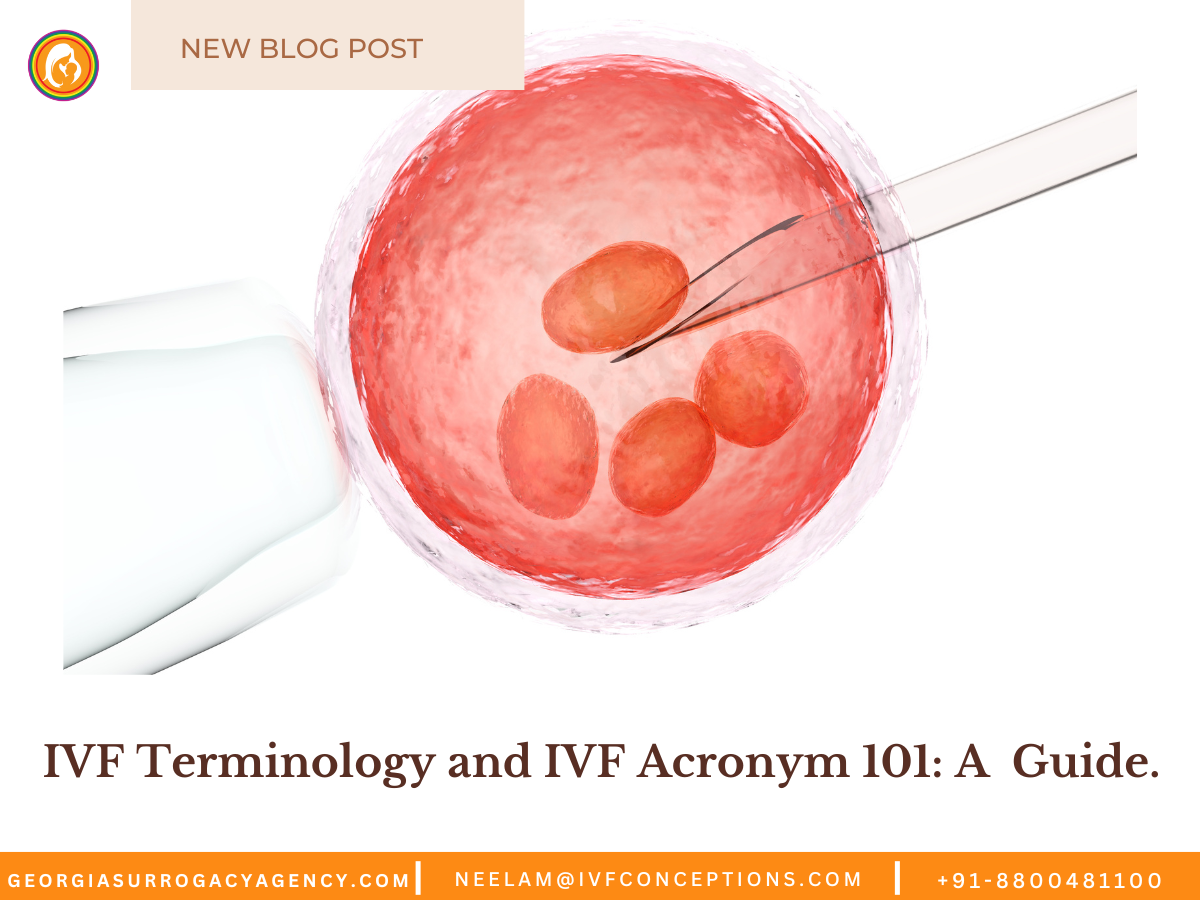Did you know over 8 million babies have been born thanks to IVF since 1978? The world of assisted reproductive technology is growing fast. It’s important for those on the fertility journey to know the terms and acronyms. This guide will help you learn key IVF terms and acronyms, making your journey easier.
- Book an online appointment: Get a free online consultation.
- Call\W:+91-8800481100 Email:neelam@ivfconceptions.com
We’ll cover everything from preconception and fertility tests to genetic and embryo terms. Knowing these words helps you talk better with your healthcare team. It also lets you make informed choices and feel more in control.
Resources to Read:
Difference Between IVF and Surrogacy: A Comprehensive Guide
IVF vs IUI: Comparing Fertility Treatment Options
Surrogacy vs IVF: Understanding the Key Differences
IVF Egg Donation in Georgia Country: A Guide
Key Takeaways
- Discover the essential IVF terminology and acronyms to navigate your fertility journey.
- Learn preconception, fertility testing, genetic, embryo, and treatment-related terms.
- Communicate effectively with your care team and advocate for yourself during the process.
- Gain a deeper understanding of the language used in assisted reproductive technology.
- Feel more informed and empowered throughout your fertility journey.
Understanding IVF: An Overview

In vitro fertilization (IVF) is a major change in how we deal with fertility issues. It’s a detailed process that carefully handles eggs, embryos, and sperm. This helps people and couples who have trouble getting pregnant to start their families.
The first step in IVF is ovarian stimulation. Here, fertility drugs help make many eggs mature. Then, a small surgery called egg retrieval gets these eggs.
Next, the eggs meet sperm in a lab. This sperm can come from the parents or a donor. The eggs and sperm create embryos.
These embryos are watched closely. Some may get genetic tests to check their health. Then, one or more embryos are put into the uterus. This is called embryo transfer. It’s a key step for the embryo to grow into a baby.
IVF can use the parents’ own eggs and sperm or donor ones. Sometimes, a gestational carrier is used. Freezing eggs, sperm, or embryos is also part of IVF. This lets people save them for later or donate them.
Learning about IVF is key for those in assisted reproductive technology. Knowing the steps and terms helps us make smart choices about our fertility treatments.
“IVF has given hope to countless individuals and couples who once thought their dreams of parenthood were out of reach.”
| IVF Step | Description |
| Ovarian Stimulation | The use of fertility medications to stimulate the ovaries to produce multiple mature eggs. |
| Egg Retrieval | A minor surgical procedure to collect the developed eggs from the ovaries. |
| Fertilization | The process of combining the retrieved eggs with sperm, either from the intended parent or a donor, to create embryos. |
| Embryo Transfer | The placement of one or more embryos into the uterus, with the goal of successful implantation and pregnancy. |
The Language of Infertility
Learning about fertility can feel like a new language. You’ll come across terms like trying to conceive (TTC) and semen analysis (SA). It’s important to know these terms. We’ll cover the basics of preconception and fertility testing to help you understand your journey.
Preconception Terms
First, let’s talk about the basics. When trying to conceive (TTC), tracking your basal body temperature (BBT) and using an ovulation predictor kit (OPK) can help. If you’re on a birth control pill (BCP), knowing how it affects your cycle is crucial for planning.
Fertility Testing Terms
Fertility tests check your hormones and reproductive health. Anti-Müllerian hormone (AMH) and follicle stimulating hormone (FSH) levels show your ovarian health. Thyroid stimulating hormone (TSH) and estradiol (E2) help understand your hormone balance.
Tests like the hysterosalpingogram (HSG) and saline infusion sonohysterogram (SIS or SHG) check your uterus and tubes. The endometrial receptivity analysis (ERA) test helps plan when to transfer an embryo in fertility treatments.
Learning these terms will help you understand your fertility better. It also makes talking with your healthcare team easier as you aim for parenthood.
“The key to success is to familiarize yourself with the language of infertility. This will help you feel more in control and better equipped to make informed decisions.”
Genetic & Embryo Testing Terminology
Understanding terms like genetic and embryo testing is key when planning for IVF. These tests check the health of embryos before they implant. Let’s look at the three main types of preimplantation genetic testing (PGT) and why they matter.
Preimplantation Genetic Testing for Aneuploidies (PGT-A)
PGT-A checks embryos for chromosomal issues. It spots problems like extra or missing chromosomes. This can lead to failed implantation or genetic issues. PGT-A boosts IVF success by picking the healthiest embryos.
Preimplantation Genetic Testing for Monogenic/Single-Gene Disorders (PGT-M)
PGT-M targets specific genetic mutations that cause inherited diseases. It lets couples avoid passing on genetic disorders to their kids. This testing gives them a chance for a healthy baby.
Preimplantation Genetic Testing for Chromosomal Structural Rearrangements (PGT-SR)
PGT-SR looks for chromosome structure problems in embryos. It’s crucial for people with a balanced chromosomal translocation. This testing helps pick embryos without the disorder, lowering miscarriage risk and chromosomal disorder risk.
Knowing about these tests helps you make smart choices for your fertility treatment. Talk to your doctor about the best tests for you.
| Type of Preimplantation Genetic Testing | Purpose |
| PGT-A (Preimplantation Genetic Testing for Aneuploidies) | Screens for chromosomal abnormalities in embryos to improve IVF success rates |
| PGT-M (Preimplantation Genetic Testing for Monogenic/Single-Gene Disorders) | Detects specific genetic mutations that can cause inherited diseases |
| PGT-SR (Preimplantation Genetic Testing for Chromosomal Structural Rearrangements) | Identifies structural abnormalities in the chromosomes of the embryo |
Learning about these tests and their goals helps you make informed choices. This can increase your chances of a healthy baby.
IVF Terminology and IVF Acronym 101
Understanding assisted reproductive technology (ART) can feel overwhelming, especially with all the terms and acronyms for IVF. But getting to know these concepts can help you make better choices and join in your fertility journey.
Intracytoplasmic sperm injection (ICSI) is a key term in IVF. It means injecting a single sperm directly into an egg. This is often used for people with male fertility issues or low sperm quality.
Testicular/epididymal sperm aspiration (TESA) is another important term. It’s a way to get sperm from the testicles or epididymis if it’s not in the semen.
During IVF, a vaginal oocyte retrieval (VOR) might happen. This is when mature eggs are taken from the ovaries using a small needle guided by ultrasound. This step is vital because the eggs can be fertilized and might become embryos.
It’s also good to know about ovarian hyperstimulation syndrome (OHSS). This is a side effect of some fertility drugs in IVF. It makes the ovaries swell and hurt, and in bad cases, you might need more medical help.
Knowing these terms and acronyms helps you talk better with your healthcare team. It lets you take part in making decisions during your IVF treatment.
“Knowledge is power, and in the world of fertility treatment, understanding the language can empower patients to be active participants in their care.”
Common IVF Acronyms

Understanding fertility treatments can be tough, especially with all the acronyms and abbreviations. We’re going to make it easier by explaining the most common IVF terms. This will help you feel more in control of your journey.
Fertility Treatment Acronyms
At the start of your fertility journey, you’ll meet a lot of new terms. Let’s look at some key ones:
- IUI – Intrauterine Insemination
- IVF – In Vitro Fertilization
- AH – Assisted Hatching
- RIVF – Reciprocal In Vitro Fertilization
- ESET – Elective Single Embryo Transfer
- 2WW – Two-Week Wait
- AF – Aunt Flo (Menstrual Period)
- ART – Assisted Reproductive Technology
- BBT – Basal Body Temperature
- BCP – Birth Control Pills
- Beta – Beta hCG Test
- BFN – Big Fat Negative (Negative Pregnancy Test)
- BFP – Big Fat Positive (Positive Pregnancy Test)
- CB – Conception Block
- CD – Cycle Day
- CDC – Centers for Disease Control and Prevention
- DE – Donor Egg
- DOR – Diminished Ovarian Reserve
- DPO – Days Past Ovulation
- DPR – Days Past Retrieval
- DPT – Days Past Transfer
- Dx – Diagnosis
- Endo – Endometriosis
- EPT – Early Pregnancy Test
- ER – Egg Retrieval
- ET – Embryo Transfer
- FET – Frozen Embryo Transfer
- FHR – Fetal Heart Rate
- Frostie – Frozen Embryo
- FSH – Follicle Stimulating Hormone
- hCG – Human Chorionic Gonadotropin
- HPT – Home Pregnancy Test
- HSG – Hysterosalpingogram
- Hx – Medical History
- ICSI – Intracytoplasmic Sperm Injection
- IF – Infertility
- IPs – Intended Parents
Learning these IVF acronyms will help you understand your fertility journey better. It will also make talking to your healthcare team easier.
Additional Resources to Read:
IVF Egg Donation in Georgia Country: A Guide
IVF Treatment in Georgia: What You Need to Know?
IVF Clinic/Maternity Hospital in Georgia
Conclusion
Throughout this guide, we’ve learned a lot about IVF terminology and acronyms. This knowledge is key for those starting the fertility journey. It helps us understand terms like preconception and fertility testing. We also learned about genetic, embryo, and IVF treatment concepts.
Now, we can talk better with our healthcare providers. We can also speak up for our needs during this important time. This makes us feel more in charge of our journey to have a family.
Learning about IVF terminology and acronyms gives us the power to understand our fertility treatment better. It helps us make smart choices and ask the right questions. This way, we can take charge of our path to growing our families.
Our fertility clinic team is always here to help and explain more as we move forward. Thanks to this guide, we can face our fertility care with confidence and clarity. We feel empowered to move forward on our journey.
If you’d like to learn more about IVF, Egg Donation, or surrogacy services globally, check out the rest of our website at Georgia Surrogacy Agency. We offer legally secure and affordable surrogacy consulting services for FREE.
Our team has over 14 years of experience facilitating surrogacy arrangements, egg donation, and serving as an advocacy resource for infertile couples and LGBTQ individuals seeking to build families.
For more resources on IVF and Surrogacy, browse our other web page- IVF Conceptions.
For more resources on IVF and Surrogacy, browse our other web page- Complete Surrogacy.
More reference:
https://www.aljazeera.com/features/2023/9/6/georgia-plans-to-ban-commercial-surrogacy
https://ge.usembassy.gov/message-for-u-s-citizens-new-law-banning-surrogacy-planned-in-georgia/
FAQ for IVF Terminology
What are some common preconception terms I should know?
Key preconception terms include “Trying to Conceive (TTC)”, “Semen Analysis (SA)”, “Basal Body Temperature (BBT)”, “Ovulation Predictor Kit (OPK)”, and “Birth Control Pill (BCP)”. These terms help you understand your fertility and talk to your healthcare team.
What fertility testing terminology should I be familiar with?
Important fertility testing terms are “Anti-Müllerian Hormone (AMH)”, “Follicle Stimulating Hormone (FSH)”, “Thyroid Stimulating Hormone (TSH)”, “Estradiol (E2)”, “Hysterosalpingogram (HSG)”, “Saline Infusion Sonohysterogram (SIS or SHG)”, and “Endometrial Receptivity Analysis (ERA)”. These terms help you understand your test results and work with your healthcare team.
What are the key terms related to genetic and embryo testing?
Key terms for genetic and embryo testing include “Preimplantation Genetic Testing (PGT)” with its types: PGT-A for aneuploidies, PGT-M for single-gene disorders, and PGT-SR for chromosomal structural rearrangements. These terms help you make informed choices about your fertility treatments.
What are some common IVF terminology and acronyms I should know?
Important IVF terms and acronyms are “Assisted Reproductive Technology (ART)”, “Intracytoplasmic Sperm Injection (ICSI)”, “Testicular/Epididymal Sperm Aspiration (TESA)”, “Vaginal Oocyte Retrieval (VOR)”, and “Ovarian Hyperstimulation Syndrome (OHSS)”. Knowing these terms helps you understand the IVF process better.
What are some common fertility treatment acronyms I should know?
Key fertility treatment acronyms are “Intrauterine Insemination (IUI)”, “In Vitro Fertilization (IVF)”, “Assisted Hatching (AH)”, “Reciprocal In Vitro Fertilization (RIVF)”, and “Elective Single Embryo Transfer (ESET)”. These abbreviations help you understand your fertility treatments and talk to your healthcare team.
What is the IVF process and how does it work?
IVF is a complex process for those facing infertility. It includes egg retrieval, fertilization in a lab, and putting the embryo into the uterus. IVF uses a couple’s or donor eggs and sperm and is a top fertility treatment. Knowing how IVF works can guide you through this treatment.

Highly esteemed, authoritative, and trusted professional with a 14-year of experience in international surrogacy. Advocate for Secure, Legal, and Affordable International Surrogacy.
Neelam Chhagani, MA (Counselling Psychology) and Holistic Infertility and Third-Party Reproduction Consultant.
Member of European Fertility Society, Best Surrogacy Blogger of 2020, with 300 dedicated blogs, and top contributor on Quora for Surrogacy.


Add Your Comment